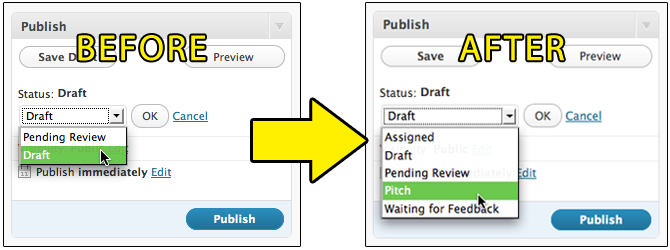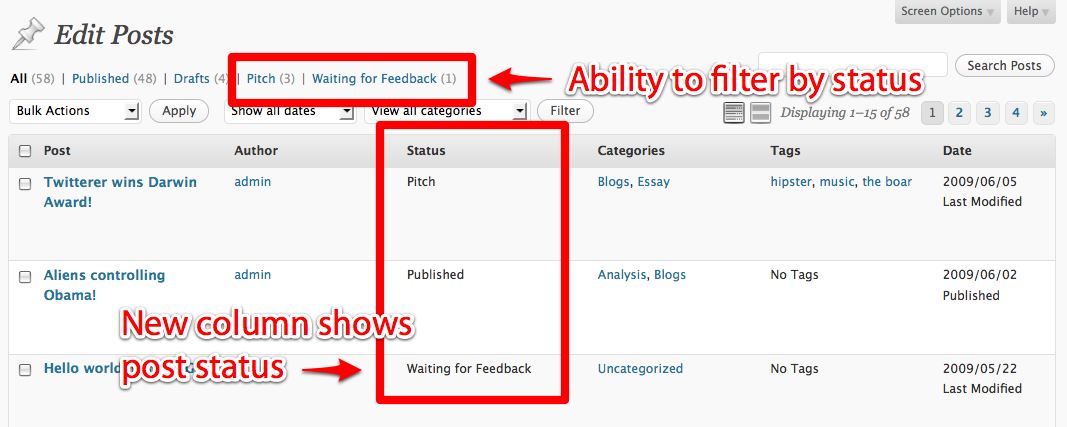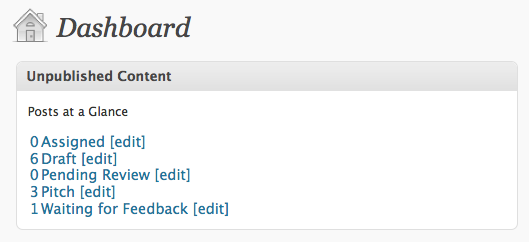This past weekend, we released the beta version of Stage 1 (Custom Post Statuses) of the Edit Flow Project, a plugin aiming to improve the WordPress Admin Interface for a multi-user newsroom’s editorial workflow.
The main goal of this stage was to “improve posts statuses by allowing custom statuses.” WordPress, by default, only allows for two statuses for posts during the editing process: “Draft” and “Pending Review”. These statuses are not very descriptive nor do they make it easy to track a story as it moves through a newsroom’s often complex, multi-level workflow.
With the release of Stage 1 of Edit Flow, WordPress users can now assign custom statuses to posts, giving them more control over the state of their content.
Adding/Editing/Managing Custom Statuses
Upon activation, the plugin adds five default statuses (“Assigned”, “Draft”, “Pending Review”, “Pitch”, “Waiting for Feedback”). These can all be edited or deleted (with the exception of “Draft” and “Pending Review”, which can only be deleted). Users can also add additional custom statuses. Overall, we tried to make this as flexible as possible, acknowledging the extreme diversity in workflows and requirements across different newsrooms.
The “Add/Edit/Manage Custom Statuses” screen (screenshot above) is reminiscent of the interface used to manage categories and tags. From a design stand-point, we tried to keep with standard WordPress interface conventions (to minimize the learning curve) and, similarly, make the plugin as less intrusive as possible.
Assigning Custom Statuses to Posts
With custom statuses defined, they can now be assigned to posts. The plugin adds the custom statuses to the “Status” dropdown when editing a post (screenshot above). Additionally, given the likely frequency of use of this feature, the Status dropdown is made visible by default. The plugin also allows you to set a default status for new posts, which WordPress sets to “Draft” by default.
Managing Posts
To ease the management of content, a new column is added to the Edit/Manage Posts screen that indicates the current status of the posts displayed. Additionally, the posts on this screen can be filtered by status, by clicking on the links at the top.
Dashboard Widget
As a small bonus, we threw in a small dashboard widget that gives you a quick glance of the state of currently unpublished content. As this was a last minute addition, it’s minimal and largely unstyled, but something we’ll clean up and build out more in the coming days.
Version Compatibility and Internationalization
The plugin relies heavily on JavaScript, and given recent changes to the core, we’ve decided to only support WordPress 2.8 onwards. If there is enough demand for backwards compatibility, we may consider supporting older versions. For now, and the remainder of the plugin, we will be focusing on compatibility with WordPress 2.8+. Additionally, internationalization isn’t currently supported, but something we hope to build into the next Stage of the plugin.
Download
You can find Stage 1 of the plugin on the WordPress Plugin Directory. Alternatively, download it from within WordPress using the built-in Plugin Manager (just search for “Edit Flow”).
Feedback and What’s Next
As this is the first official (albeit beta) release of Edit Flow, it is likely still rough around the edges. We’re very open to feedback though. Leave a comment below telling us what you think is broken, missing, or could be improved. (Praise doesn’t hurt either). Alternatively, feel free to submit any issues or requests that you run into on our GitHub page.
Up next, Daniel will be leading efforts for Stage 2 (Additional Post Meta Data) of the plugin, which will be working to add newsroom specific meta-data to posts. Stay tuned to our progress as we work through Stage 2.





I was excited to see this plug-in. It’s supposed to do exactly what I need to do. my only problem is that I can’t get it to work with WP MU. Any ideas?
I will be using this on stand-alone WP installations, but I’d love to also use it on the sites that are running out of WP MU.
We haven’t actually tested it or confirmed that it works in WordPress MU yet, although getting it to do so is obviously preferable. We’re still adding features and I’ll make sure that we get it to work in MU in a release for the near future.
Thanks, Daniel. If you need testers at any stage, let me know.
I have gotten it to work with WordPress MU version 2.8.4a and BuddyPress. I am not sure what Jennifer did, but it does what the page shows in the Edit Posts area.
This plug-in will really improve our post and page work flow! I have come across one issue that I’m not exactly sure how to resolve. I’m hoping that you can provide me with some ideas on how to proceed. We are currently using WP version 2.8.5.
Everything appears to work perfectly in the post area, however, the Edit Flow widget is not appearing in the Page screens. The other issue I noticed, I am unable to open any of the existing widgets in the page area if they are closed.
I noticed in the plug-ins edit area the edit-flow/php/post.php file that appears to me to be establishing and controlling the Edit Flow widget in the Post area. Do I need a similar file to handle those items in a page? Or is there a statement missing in my templates page.php that I need to include?
Any assistance you could provide would be greatly appreciated!
Hi coloradoouting,
Glad to hear the Edit Flow will come in handy with your workflow. Looks like there was a bit of an oversight on our part and we forgot to enable the Edit Flow metabox for Pages. We’ll try to see if we can add it in with the next version.
Until then, if you’re really interested in enabling it for pages try the following: Locate the add_post_meta_box function in edit-flow/php/post.php and replace it completely with this function. That should work, though we haven’t tested it, so be warned that there may be bugs.
Hey Mo,
Thanks for the suggestion! It enabled the metabox for pages and everything seems to be working fine. One thing I did notice since first installing Edit Flow, I’m unable to open/close the other metaboxes in pages, even after applying your function suggestion.
The metaboxes work fine in posts, in fact, if I go into any post and open the metabox that I want, it will then be open in pages?? Doable, but not very convenient..haha!
@coloradoouting: Glad to hear it worked! And the metabox issue is a known bug but we’ll hopefully have it fixed for the next release.
Thanks for using Edit Flow!